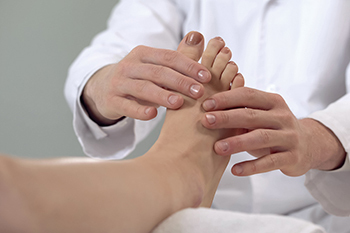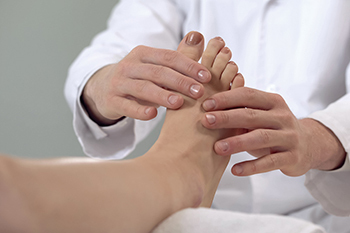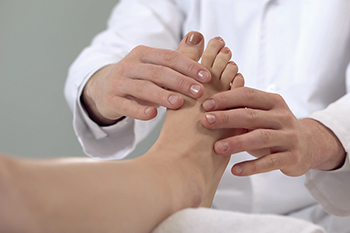Items filtered by date: September 2022
Why Ankle Pain Occurs

Having ankle pain is a good indicator that an injury has happened to the ankle bone or the surrounding joints. The ankle is in the perfect position where the foot bones and leg connect. There are three joints in the ankle, and each has a function. These functions include providing stability to hold the body’s weight, moving the body forward while walking or running, and providing shock absorption for daily movements. Common symptoms that can accompany ankle pain is the inability to walk, swelling, and the ankle can have a throbbing or tingling sensation. The pain from an Achilles tendon injury may travel to the ankle and can make it difficult to complete daily activities. Additional reasons why ankle pain occurs include having arthritis, bursitis, edema, or an ankle fracture. Many times, there is a distinctive reason why ankle pain exists, so it is strongly suggested that a podiatrist be consulted who can perform a proper diagnosis and treat your ankle pain.
Ankle pain can have many different causes and the pain may potentially be serious. If you have ankle pain, consult with one of our podiatrists from Toe-tal Family Footcare Associates. Our doctors will assess your condition and provide you with quality foot and ankle treatment.
Ankle pain is any condition that causes pain in the ankle. Due to the fact that the ankle consists of tendons, muscles, bones, and ligaments, ankle pain can come from a number of different conditions.
Causes
The most common causes of ankle pain include:
- Types of arthritis (rheumatoid, osteoarthritis, and gout)
- Ankle sprains
- Broken ankles
- Achilles tendinitis
- Achilles tendon rupture
- Stress fractures
- Tarsal tunnel syndrome
- Plantar fasciitis
Symptoms
Symptoms of ankle injury vary based upon the condition. Pain may include general pain and discomfort, swelling, aching, redness, bruising, burning or stabbing sensations, and/or loss of sensation.
Diagnosis
Due to the wide variety of potential causes of ankle pain, podiatrists will utilize a number of different methods to properly diagnose ankle pain. This can include asking for personal and family medical histories and of any recent injuries. Further diagnosis may include sensation tests, a physical examination, and potentially x-rays or other imaging tests.
Treatment
Just as the range of causes varies widely, so do treatments. Some more common treatments are rest, ice packs, keeping pressure off the foot, orthotics and braces, medication for inflammation and pain, and surgery.
If you have any questions, please feel free to contact our office located in Vista, CA and Las Vegas, NV . We offer the newest diagnostic and treatment technologies for all your foot care needs.
Various Reasons Why Feet Can Become Swollen

Excessive fluid in the feet can cause extreme swelling. This is an uncomfortable feeling, and is known as edema. Some of the symptoms that can accompany swollen feet include bruising, numbness, and the feet may feel stiff. When the feet become swollen, it may be indicative of existing medical conditions, which include arthritis. Additionally, it may happen as a result of an ankle sprain or fracture, and this typically happens immediately. The feet may become swollen from an insect bite, and this is considered to be an allergic reaction. Some people notice their feet can become swollen from standing for extended periods of time throughout the day, and can be very common among pregnant women. The warmer temperatures may cause the feet to become swollen, and it is suggested that sodium intake is reduced. If your feet are swollen, please schedule an appointment with a podiatrist who can effectively determine what the cause is, and offer correct treatment options.
Swollen feet can be a sign of an underlying condition. If you have any concerns, contact one of our podiatrists of Toe-tal Family Footcare Associates. Our doctors can provide the care you need to keep you pain-free and on your feet.
Swollen feet are a common ailment among pregnant women and people who stand or sit for extended periods. Aging may increase the possibility of swollen feet and patients who are obese often notice when their feet are swelling too. There may be medical reasons why swollen feet occur:
- Phlebitis - A condition that causes the veins to become inflamed and can also cause leg pain.
- Liver disease - This may lead to low blood levels of albumin which is a protein. This can cause fluid in the blood to pass into the tissues and several areas of the body can become swollen.
- Heart failure - When the heart doesn’t pump properly the blood that is normally pumped back to the heart can pool in the veins of the legs causing swollen feet.
- Kidney disease - One of the main functions of the kidneys is releasing excess fluid in the body. This type of condition can make it difficult for the kidneys to function properly, and as a result the feet may become swollen.
- Deep-vein thrombosis (DVT)- This is a serious condition where blood clots form in the veins of the legs. They can block the return of blood from the legs to the heart which may cause the feet to swell. It is important to be treated by a podiatrist if this condition is present.
Swollen feet can also be caused by bone and tendon conditions, including fractures, arthritis, and tendinitis. Additionally, there may be skin and toenail conditions and an infection may cause the feet to swell. Patients who take medicine to treat high blood pressure may be prone to getting swollen feet.
Many patients elevate their feet to help relieve the swelling and this is generally a temporary remedy. When a podiatrist is consulted the reason behind the swelling can be uncovered and subsequently treated.
If you have any questions please feel free to contact our office located in Vista, CA and Las Vegas, NV . We offer the newest diagnostic tools and technology to treat your foot and ankle needs.
Sesamoiditis in Runners

Sesamoiditis is a particular kind of foot condition that primarily impacts the two small bones underneath the big toe. These bones are known as the sesamoids, and they are directly situated behind the joint in the big toe. Sesamoiditis occurs when these bones and the surrounding tendons become inflamed. Some runners can be particularly susceptible to developing sesamoiditis. This is because when an individual runs, they put a significant amount of pressure onto the sesamoids. As a result, runners might even fracture the sesamoids. If a runner uses poor form and improper running techniques, the extent to which the sesamoids could become strained is only exacerbated. Sesamoiditis can be particularly detrimental to runners because having this condition can make the act of running extremely painful. For example, it is difficult to run when your sesamoiditis makes your feet feel tender. You may also feel as though it is difficult or uncomfortable to put weight on your feet. Unfortunately, sesamoiditis can be a headache for runners. If you are a runner who has sesamoiditis or are looking to prevent this condition, contact a podiatrist.
Sesamoiditis is an unpleasant foot condition characterized by pain in the balls of the feet. If you think you’re struggling with sesamoiditis, contact one of our podiatrists of Toe-tal Family Footcare Associates. Our doctors will treat your condition thoroughly and effectively.
Sesamoiditis
Sesamoiditis is a condition of the foot that affects the ball of the foot. It is more common in younger people than it is in older people. It can also occur with people who have begun a new exercise program, since their bodies are adjusting to the new physical regimen. Pain may also be caused by the inflammation of tendons surrounding the bones. It is important to seek treatment in its early stages because if you ignore the pain, this condition can lead to more serious problems such as severe irritation and bone fractures.
Causes of Sesamoiditis
- Sudden increase in activity
- Increase in physically strenuous movement without a proper warm up or build up
- Foot structure: those who have smaller, bonier feet or those with a high arch may be more susceptible
Treatment for sesamoiditis is non-invasive and simple. Doctors may recommend a strict rest period where the patient forgoes most physical activity. This will help give the patient time to heal their feet through limited activity. For serious cases, it is best to speak with your doctor to determine a treatment option that will help your specific needs.
If you have any questions please feel free to contact our office located in Vista, CA and Las Vegas, NV . We offer the newest diagnostic and treatment technologies for all your foot and ankle needs.
Various Reasons Why a Heel Spur May Develop

People who develop heel spurs are aware of the pain and discomfort they may cause. It is defined as a bony growth on the back of the heel and between the arch, and is generally felt while walking and running. It is a calcium deposit, and wearing shoes that do not fit correctly may increase the risk of getting a heel spur. They may be one of three shapes, including pointed, shelf-like, and hooked, and may be up to a half inch long. The common symptoms that many patients experience can consist of a chronic ache in the heel of the foot, and there may be inflammation and swelling in the affected area. Additionally, it is often tender to the touch, and it may feel warm. A heel spur happens as a result of strained ligaments and muscles that gradually wear out the soft tissues in the heel. People who have experienced a heel injury, are overweight, or who frequently run and jump on hard surfaces, may be at a greater risk for developing a heel spur. Mild relief can come from resting the affected foot as often possible, and wearing shoes that have adequate support and cushioning. If you have been afflicted by a heel spur, it is suggested that you confer with a podiatrist who can recommend correct treatment options, which may include surgery for permanent removal.
Heel spurs can be incredibly painful and sometimes may make you unable to participate in physical activities. To get medical care for your heel spurs, contact one of our podiatrists from Toe-tal Family Footcare Associates. Our doctors will do everything possible to treat your condition.
Heels Spurs
Heel spurs are formed by calcium deposits on the back of the foot where the heel is. This can also be caused by small fragments of bone breaking off one section of the foot, attaching onto the back of the foot. Heel spurs can also be bone growth on the back of the foot and may grow in the direction of the arch of the foot.
Older individuals usually suffer from heel spurs and pain sometimes intensifies with age. One of the main condition's spurs are related to is plantar fasciitis.
Pain
The pain associated with spurs is often because of weight placed on the feet. When someone is walking, their entire weight is concentrated on the feet. Bone spurs then have the tendency to affect other bones and tissues around the foot. As the pain continues, the feet will become tender and sensitive over time.
Treatments
There are many ways to treat heel spurs. If one is suffering from heel spurs in conjunction with pain, there are several methods for healing. Medication, surgery, and herbal care are some options.
If you have any questions feel free to contact our office located in Vista, CA and Las Vegas, NV . We offer the latest in diagnostic and treatment technology to meet your needs.
